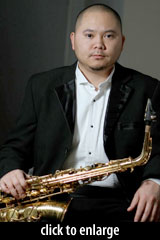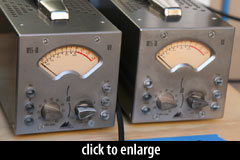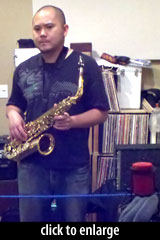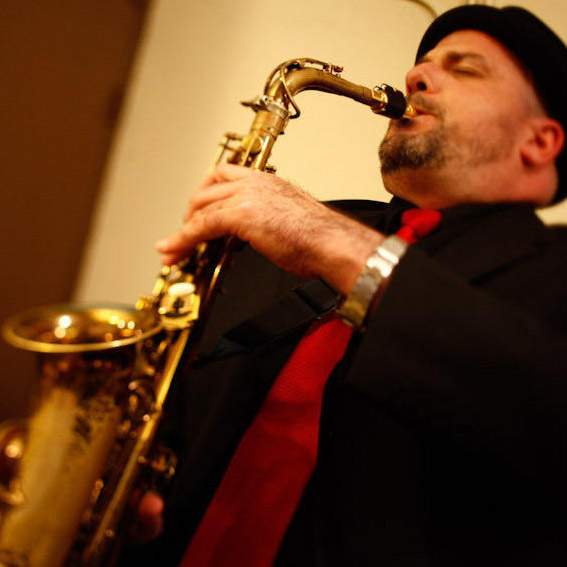
Ribbon Shootout: Alto Sax
Thursday, July 28th, 2011 | by matthew mcglynn
 The sax session of the $60,000 Ribbon Microphone Shootout was recorded at Ditch Road Records. The star of the show was a local horn player named Jon Cruz who teaches and performs all around Los Angeles.
The sax session of the $60,000 Ribbon Microphone Shootout was recorded at Ditch Road Records. The star of the show was a local horn player named Jon Cruz who teaches and performs all around Los Angeles.
Jon came prepared with a beautiful piece of music — what he describes as “an embellished version of George Gershwin’s Summertime.” I’m pretty sure he’d never been asked to play the exact same lick 20 times in a row before, but he did it admirably here.
His horn is a Yamaha 62 alto, with a Beechler metal 8 mouthpiece and a Vandoren Java size 2 reed.
Test Setup and Signal Path
Having primarily tested with close mic placements thus far, we wanted to move back a bit and capture some of the room. We had Jon stand on a carpet, about 4' back from the mics. We oriented the ribbons vertically, and used a string jig to maintain equal positions for every test.
We recorded the mics in pairs, because we had too many to do them singly. This turned out to be a problem, although we didn’t realize it until much later: the two positions sounded different. The difference is actually visible in the waveforms.
 The Cascade Fat Head II (Lundahl) was recorded once in each position. If you listen to the held note at the beginning of the second phrase, you’ll hear at least 7dB more at 400Hz in the first compared to the second. The first has about 3dB less at 800Hz too. (Presumably Jon was playing an A, eh?)
The Cascade Fat Head II (Lundahl) was recorded once in each position. If you listen to the held note at the beginning of the second phrase, you’ll hear at least 7dB more at 400Hz in the first compared to the second. The first has about 3dB less at 800Hz too. (Presumably Jon was playing an A, eh?)
Fathead from group 1
Fathead from group 2
The Ditch Road live room is fairly live, so I’m guessing the two mic positions were sitting in a 400Hz standing wave, with the first mic in a peak, and the second in a null. Whatever the explanation, we’ve separated the samples into “group 1” and “group 2,” and although it’s disappointing that samples from one can’t be fairly compared to samples from the other, there is still a lot to hear.
 On this test, we used a pair of Martech MSS-10 preamps for all mics. The MSS-10 has plenty of gain, and phantom power, and a stellar reputation for pristine sound — or as Joe Chiccarelli puts it, “hi-fi with soul.” (FYI: these things street for $1900/channel.)
On this test, we used a pair of Martech MSS-10 preamps for all mics. The MSS-10 has plenty of gain, and phantom power, and a stellar reputation for pristine sound — or as Joe Chiccarelli puts it, “hi-fi with soul.” (FYI: these things street for $1900/channel.)
Audio Files
 The session was tracked at 24 bit, 48kHz, using Ryan’s SSL XLogic Alpha-Link converters. I gain-matched the tracks in Pro Tools, and output them as full-resolution WAV files that you can download here. Or listen below to the 320kbps MP3s.
The session was tracked at 24 bit, 48kHz, using Ryan’s SSL XLogic Alpha-Link converters. I gain-matched the tracks in Pro Tools, and output them as full-resolution WAV files that you can download here. Or listen below to the 320kbps MP3s.
Group 1
Group 2
Listening Notes
 I’m glad we put an SM57 into the first group. It provides an important sonic contrast. I liked all the ribbons better. The SM57 picked up more valve noise, and its midrange sounds a little ragged. All the ribbons are smoother, not to mention less honky.
I’m glad we put an SM57 into the first group. It provides an important sonic contrast. I liked all the ribbons better. The SM57 picked up more valve noise, and its midrange sounds a little ragged. All the ribbons are smoother, not to mention less honky.
The standouts in the first group, for me, are the Royer R-122V and Coles 4038. Their combination of warmth and openness is unnerving (in a really good way). The Coles is brighter; maybe because I’ve been listening to ribbons so much lately, I’m almost tempted to roll off some of its high end.
Randy Coppinger didn’t pick favorites, but I’ll quote from his notes here:
Randy Coppinger
Coles 4038 – immediate, balanced, thick
Royer R-122V – Smooth, rich, sexy, glassy on top
I like the  AEA R44CX too. It is slightly veiled, but only in comparison to some of these other choices.
AEA R44CX too. It is slightly veiled, but only in comparison to some of these other choices.
Unlike the drum overhead test, I don’t find that the brighter-sounding ribbons necessarily score more points here. The brighter mics bring out valve noise and breath, but more than that, the brightness doesn’t sound like part of the instrument. Compare the Voodoo mics (which have an enhanced high-frequency response) to the  Sontronics Sigma, whose vintage vibe works in its favor here.
Sontronics Sigma, whose vintage vibe works in its favor here.
Ryan Canestro
The Royer R-121 and Coles 4038 are my top two mics on sax.
Royer Labs R-121 – This mic is silky and strong. It brings together the two sweet spots of low mid warmth and smooth bright top end usually mutually exclusive to either vintage or modern ribbon microphone designs.
Coles Electroacoustics 4038 – This microphone has a strong vintage character that is instantly recognizable and infinitely usable. I have always liked the way this microphone looked in the catalogs and now I love the way it sounds!
The
Samar Audio Design MF65 (#5) had a great balance of modern sound with a hint of that vintage magic. It was very balanced across the frequency spectrum and present on the top end without being exaggerated.
Both Shure microphones
KSM313 and KSM 353 were great examples of the modern ribbon sound. They are an excellent compromise for those that expect to hear that condenser sound, but get the added benefits of that great natural ribbon feel.
In the second set, I’m sad to say all the mics sounded a bit “off.” Having listened so closely to the first set, the missing information at 400Hz (and multiples) makes these mics sound thin.
Still, a few stand out: the  SE Electronics RNR1 brings that smooth, dark ribbon sound with an extra dose of you-are-there realism.
SE Electronics RNR1 brings that smooth, dark ribbon sound with an extra dose of you-are-there realism.
The  Shure KSM353 sounds good in a different way; I’ll agree with Ryan’s characterization of it as having a “modern” sound. There’s a hardness to it. It is similar to what I would usually call presence, but with more of an edge.
Shure KSM353 sounds good in a different way; I’ll agree with Ryan’s characterization of it as having a “modern” sound. There’s a hardness to it. It is similar to what I would usually call presence, but with more of an edge.
I liked the  AEA KU4 here, too. (Remember, this is a supercardioid mic.) The first time I’d heard this mic on sax, I really missed the liveness of the room — but in that session, the comparison mic (an AEA A840) had its rear lobe pointed at the control-room glass, which was sending high-volume reflections into the back of the mic. In this case, where we’d softened up the back half of the room, there is less apparent difference in the perceived size of the space when comparing the figure-8 mics to this unidirectional mic.
AEA KU4 here, too. (Remember, this is a supercardioid mic.) The first time I’d heard this mic on sax, I really missed the liveness of the room — but in that session, the comparison mic (an AEA A840) had its rear lobe pointed at the control-room glass, which was sending high-volume reflections into the back of the mic. In this case, where we’d softened up the back half of the room, there is less apparent difference in the perceived size of the space when comparing the figure-8 mics to this unidirectional mic.
Wrapping up
I am encouraged that a lot of these mics sounded good. One of the important takeaways from this project is that most of these mics sound pretty good on multiple sources.
If you’ve been listening to all the samples you are probably beginning to get to know what some of these individual mics are good at, and to develop some preferences for what you’d like to use on various sources. I know I have. We’ll get more into this in a future installment.
Session Download
The raw audio files for the sax session can be found here. “Enjoy them with someone you love.”
Still more…
Other stories from this series:
- Introduction to the $60k Ribbon Mic Shootout
- List of Ribbon Microphones Tested
- Guitar Cab Session 1: Fender
- Guitar Cab Session 2: Marshall
- Drum Overhead Sessions
- Saxophone Session (YOU ARE HERE)
- Voiceover Session
- Acoustic Guitar Session
- 24-bit audio file archive
- Wrap-up and Conclusions
Please leave a comment if you’re finding these reports useful. Don’t be shy about clicking the ‘Like’ and ‘+1’ buttons in the sidebar; they make a difference!
Posted in Acoustics, Microphones, Reviews, Shootouts | 10 Comments »





























james grant
September 13th, 2011 at 8:27 pm
great review might not agree with all the mic’s you chose over othiers but every budys got different likes and dislikes
John Bayne
November 8th, 2011 at 10:34 pm
Of hand the one that stood out for me was the Royer 121 and the Royer 101. I am wondering how the MXLR77 would have gone here. I think that the tenor saxohone is the real test saxophone for microphones and sound however. For example, look up MXLR77 demo with Brian Williams of Deltanaught singing Nutbush City Limits much better than Bob Seager or Tina Turner but the tenor sax from 1.52-2.05 really had its resonance, presence and buzz captured by the R77. I think it was an R77 because it had the same features accntuated in the sound as Brian Willaims raspy voice. I have just purchase a standard R77 (there was not a Lundahl transformer option or I would have chosen it over a standard R77 plus the R144 like I have just bought. In my family I major on the tenor sax and my brother the trumpet and my daugher the clarinet and I am so pleased with our trio sound that I am hoping to record them together on the R144 and myself (saxes far more comlex to captivate with their 100% conical bore coupled with single reed) on the R77 using a Zoom H4N to do the rest. It is much appreciated that you appreciate ribbon mics so much as I prefer them to even the tube mics. Just look at Brian Willaims using the tube Genesis compared with when he uses the R77. The only place the Genesis had it over the ribbon R77 was on the background keyboard sound.
Igor
January 4th, 2012 at 2:21 pm
The ones that stood out to me here were the Karma Audio K6 and Royer R-101.
Igor
January 9th, 2012 at 9:33 am
On a second listen, I still like the Karma Audio K6, but would choose the Audio-Technica AT4080 over the Royer R-101.
chuck
February 24th, 2012 at 8:04 am
as a sax player, i take issue with the fact that there was nothing placed behind the ribbons to block sound coming from the back of the mic. on all of these, you can hear the room reflections and it is not a pretty sound, which, to me, ruins all of these recordings. it’s impossible to make a valid judgement because the sound picked up from the mic is not exclusively the sax, but also a very large amount of mediocre-sounding room.
tonmeister
March 16th, 2013 at 12:32 pm
I´m also a sax player. I have a generic small ribbon chinese design that I have tried sometimes on my studio. It has a nasty midrange coloration that I can detect on most of the samples here. I prefer a more natural sound for recording sax. For me the standouts were 1. Voodoo VR1 2. Samar 3. Coles 4038. The Coles is creamy, the Samar has wonderful extension and the Voodoo is a surprise, it combines the best of the former. These tree sounded very linear to me with the Voodoo and Samar having great high frecuency extension.
Sean Tompkins
October 9th, 2013 at 11:14 am
Hey, I like the selection of ribbon microphones that Ryan Canestro has put together (Royer Labs R121, Coles 4038, MF65, KSM 313 and the SE Electronics RNR1) . I am currently an audio studio at the Art Institute of Washington and is currently doing some research myself on microphones. I was wondering if you had any WAV files recordings from those microphones that I can present during my presentation. I greatly appreciate it.
morrie louden
November 27th, 2015 at 10:24 pm
I am mostly a jazz engineer and have become a real lover of ribbons on horns. It’s so much more musical than condensers. I like all the smoothness but I always look for the big body of the sound too. Everyone talks about the Royer 121 as being the general favorite but not for me. Yes, it is silky and forgiving in the high end but, it just doesn’t carry the weight like a RCA 44. My picks are the AEA R44C , Coles 4038 and last but certainly not least, Samar MF65s/n 6. The Samar was a new discovery for me. Super sweet !
I would have preferred the test be with a tenor and a little better sounding room but still a great test and much appreciated! Thank You!!
Geoff Poulton
February 14th, 2017 at 7:57 am
Tonmeister, you have it in one !
Keith
April 21st, 2020 at 8:10 am
Oh, man! That M130 tone, pure butter… That’s the sound I love for jazz tenor saxophone. What a surprise. (Yep, that’s the opposite of the bright pop saxophone tones…)